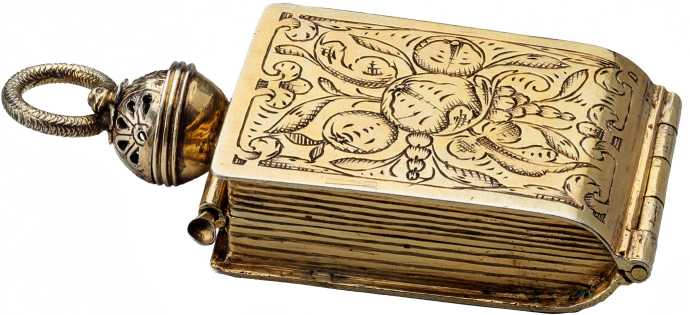


Pomander in the form of a Book
, Southern Germany, c. 1620–1650


Pomander in the form of a Book
Description
The world was a smelly place before modern plumbing. One defense against the olfactory assault was perfume and pleasant aromas that one might daub on one’s body or carry. But it wasn’t only defense against odors that led to the practice of using a pomander. Various ointments and herbs with distinctive smells were considered beneficial to health and the proper care of a virtuous body. They were even preventative of infection or “corruption of the air.” For these reasons, it is no surprise that a pomander would turn up attached to a rosary, or that a reliquary should take the shape of a pomander. They were usually worn attached to belts.
This pomander is exceptional in taking the form of a book. An inescapable connotation is that its contents are not only beneficial, but represent an informed approach to bodily care, based on scholarship and learning. Indeed, the interior is compartmentalized, and a set of inscribed labels follows the recommendations of a German publication, Die Württenberger Apothekentaxe von 1626. The inscriptions refer to poison plum balm, an oil-based plant, amber balm, balm for frizzy hair, cinnamon balm, pomade for the treatment of hair, cloves balm, nutmeg oil, lavender balm, apoplexy salt, and rose balm. This is an exceptional number of balms and oils, as many as twice the usual number.
Description
Gilded silver pomander in the form of a book with hinged covers, with a small spoon as a clasp. Inside are six compartments on either side of a hinged central divider engraved with the names of substances contained in each compartment: GIEFT.LATW. (Gift Latwerge = poison plum pulp), BERNST.B. (amber balm), RAVT.B. (Raute Balsam = oil based plant), KRVSE.B. (Krause Balsam = balm for frizzy hair), ZIMET.B (cinnamon balm), POMMER.OEL. (hair pomade), NEGLEN.B. (clove balm), GVLD.EI. (gold), MVSCAT. OEL (nutmeg oil), LAVEN.B. (lavender balm), SCHLAG.SAL (apoplexy salt), ROSEN.B. (rose balm). A serpent-shaped pendant loop rests on a miniature spherical pomander in openwork. The book cover is finely engraved with fruits and foliage.
Comparisons and Literature
The book form as a pomander is extremely rare. A smaller version exists from the period of James I, c. 1610 (Delieb 2002, p. 76, plate 116) in the Wellcome Collection, London (Smollich 1983, no. 56, inv. no. A 642182). Pomanders often contained four to six different spices, scents, and balms; this example, however, is exceptional in its form, craftsmanship, and also in its container for twelve substances, with a miniature pomander on top. The owner must have come from a prominent and wealthy family. The identification of the various substances contained in this pomander has been confirmed by Heiner Meininghaus and is based on a book published in Germany Die Württenberger Apothekentaxe von 1626. The fine engraving with various designs on the cover combines pea-pod ornaments and botanical drawings of the period, probably from southern Germany (cf. Berliner 1925, vol. 2, no. 326).